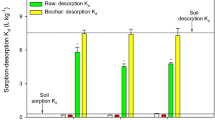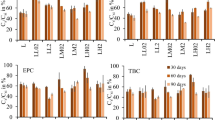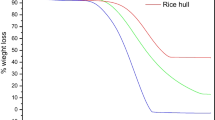Abstract
This study investigated the effect of two willow (Salix spp.) biochars, produced using either fast- or slow-pyrolysis, on the bioavailability of metsulfuron and sulfentrazone herbicides in soil. Five rates (0%, 1%, 2%, 3%, and 4%; w/w) of each biochar were used, along with varying rates of metsulfuron (0–3.2 µg ai kg−1) and sulfentrazone (0–200 µg ai kg−1), followed by a sugar beet bioassay. The fast-pyrolysis biochar had minimal effect, while the slow-pyrolysis biochar decreased the bioavailability of both herbicides. Despite using the same feedstock, the two biochars had different physical and chemical properties, of which specific surface area was most contrasting (3.0 and 175 m2 g−1 for fast- and slow-pyrolysis biochar, respectively). Increased anionic herbicide adsorption associated with greater surface area of the slow-pyrolysis biochar is considered to be the primary mechanism responsible for reducing herbicide bioavailability with this biochar.


Similar content being viewed by others
References
Ahmed HP, Schoenau JJ (2015) Effects of biochar on yield, nutrient recovery, and soil properties in a canola (Brassica napus L)-wheat (Triticum aestivum L) rotation grown under controlled environmental conditions. Bioenerg Res 8:1183–1196
Beesley L, Moreno-Jiménez E, Gomez-Eyles JL, Harris E, Robinson B, Sizmur T (2011) A review of biochars’ potential role in the remediation, revegetation and restoration of contaminated soils. Environ Pollut 159:3269–3282
Brewer CE (2012) Biochar characterization and engineering. Dissertation, Iowa State University
Brown RA, Kercher AK, Nguyen TH, Nagle DC, Ball WP (2006) Production and characterization of synthetic wood chars for use as surrogates for natural sorbents. Org Geochem 37:321–333
Cantrell KB, Hunt PG, Uchimiya M, Novak JM, Ro KS (2012) Impact of pyrolysis temperature and manure source on physicochemical characteristics of biochar. Bioresour Technol 107:419–428
Cao X, Harris W (2010) Properties of dairy-manure derived biochar pertinent to its potential use in remediation. Bioresour Technol 101:5222–5228
Cao X, Ma L, Gao B, Harris W (2009) Dairy-manure derived biochar effectively sorbs lead and atrazine. Environ Sci Technol 43:3285–3291
Government of Saskatchewan (2017) Guide to crop protection. Saskatchewan Ministry of Agriculture. http://publications.gov.sk.ca/documents/20/87089-2017%20Guide%20to%20Crop%20Protection_complete.pdf Accessed 17 July 2017
Graber ER, Tsechansky L, Khanukov J, Oka Y (2011) Sorption, volatilization, and efficacy of the fumigant 1,3-dichloropropene in a biochar-amended soil. Soil Sci Soc Am J 75:1365–1373
Graber ER, Tsechansky L, Gerstl Z, Lew B (2012) High surface area biochar negatively impacts herbicide efficacy. Plant Soil 353:95–106
Hangs RD, Ahmed HP, Schoenau JJ (2016) Influence of willow biochar amendment on soil nitrogen availability and greenhouse gas production in two fertilized temperate prairie soils. Bioenerg Res 9:157–171
Jeffery S, Verheijen FGA, van der Velde M, Bastos AC (2011) A quantitative review of the effects of biochar application to soils on crop productivity using meta-analysis. Agric Ecosyst Environ 144:175–187
Jones DL, Edwards-Jones G, Murphy DV (2011) Biochar mediated alterations in herbicide breakdown and leaching in soil. Soil Biol Biochem 43:804–813
Karhu K, Mattila T, Bergström I, Regina K (2011) Biochar addition to agricultural soil increased CH4 uptake and water holding capacity—results from a short-term pilot field study. Agric Ecosyst Environ 140:309–313
Lehmann J, Gaunt J, Rondon M (2006) Bio-char sequestration in terrestrial ecosystems—a review. Mitig Adapt Strat Glob Chang 11:403–427
Lehmann J, Rillig MC, Thies J, Masiello CA, Hockaday WC, Crowley D (2011) Biochar effects on soil biota—a review. Soil Biol Biochem 43:1812–1836
Park JH, Choppala GK, Bolan NS, Chung JW, Chuasavathi T (2011) Biochar reduces the bioavailability and phytotoxicity of heavy metals. Plant Soil 348:439–451
Seefeldt SS, Jensen JE, Fuerst EP (1995) Log-logistic analysis of herbicide dose-response relationships. Weed Technol 9:218–227
Spokas KA, Koskinen WC, Baker JM, Reicosky DC (2009) Impacts of woodchip biochar additions on greenhouse gas production and sorption/degradation of two herbicides in a Minnesota soil. Chemosphere 77:574–581
Szmigielski AM, Schoenau JJ, Irvine A, Schilling B (2008) Evaluating a mustard root-length bioassay for predicting crop injury from soil residual flucarbazone. Commun Soil Sci Plant Anal 39:413–420
Szmigielski AM, Schoenau JJ, Johnson EN, Holm FA, Sapsford KL, Liu J (2009) Development of a laboratory bioassay and effect of soil properties on sulfentrazone phytotoxicity in soil. Weed Technol 23:486–491
Szmigielski AM, Schoenau JJ, Johnson EN, Holm FA, Sapsford KL, Liu J (2012) Effects of soil factors on phytotoxicity and dissipation of sulfentrazone in Canadian prairie soils. Commun Soil Sci Plant Anal 43:896–904
Yang Y, Sheng G, Huang M (2006) Bioavailability of diuron in soil containing wheat-straw-derived char. Sci Total Environ 354:170–178
Yang XB, Ying GG, Peng PA, Wang L, Zhao JL, Zhang LJ, Yuan P, He HP (2010) Influence of biochars on plant uptake and dissipation of two pesticides in an agricultural soil. J Agric Food Chem 58:7915–7921
Yu XY, Ying GG, Kookana RS (2009) Reduced plant uptake of pesticides with biochar additions to soil. Chemosphere 76:665–671
Yu XY, Pan LG, Ying GG, Kookana RS (2010) Enhanced and irreversible sorption of pesticide pyrimethanil by soil amended with biochars. J Environ Sci 22:615–620
Zhang G, Zhang Q, Sun K, Liu X, Zheng W, Zhao Y (2011) Sorption of simazine to corn straw biochars prepared at different pyrolytic temperatures. Environ Pollut 159:2594–2601
Zheng W, Guo M, Chow T, Bennett DN, Rajagopalan N (2010) Sorption properties of greenwaste biochar for two triazine pesticides. J Hazard Mater 181:121–126
Acknowledgements
The authors wish to thank NSERC (Discovery Grant) for funding this research; Bill Schroeder and Chris Stefner (Agriculture and Agri-Food Canada Agroforestry Development Centre) for providing the willow feedstock; Saskatchewan Research Council (Michael Patterson, Erin Powell, M. Providenti, and Jordan Wicks) and Biochar Solutions Inc. (Jonah Levine) for providing the willow biochar; and the anonymous reviewers for their critical comments and suggestions that improved the manuscript.
Author information
Authors and Affiliations
Corresponding author
Rights and permissions
About this article
Cite this article
Szmigielski, A.M., Hangs, R.D. & Schoenau, J.J. Bioavailability of Metsulfuron and Sulfentrazone Herbicides in Soil as Affected by Amendment with Two Contrasting Willow Biochars. Bull Environ Contam Toxicol 100, 298–302 (2018). https://doi.org/10.1007/s00128-017-2212-5
Received:
Accepted:
Published:
Issue Date:
DOI: https://doi.org/10.1007/s00128-017-2212-5




